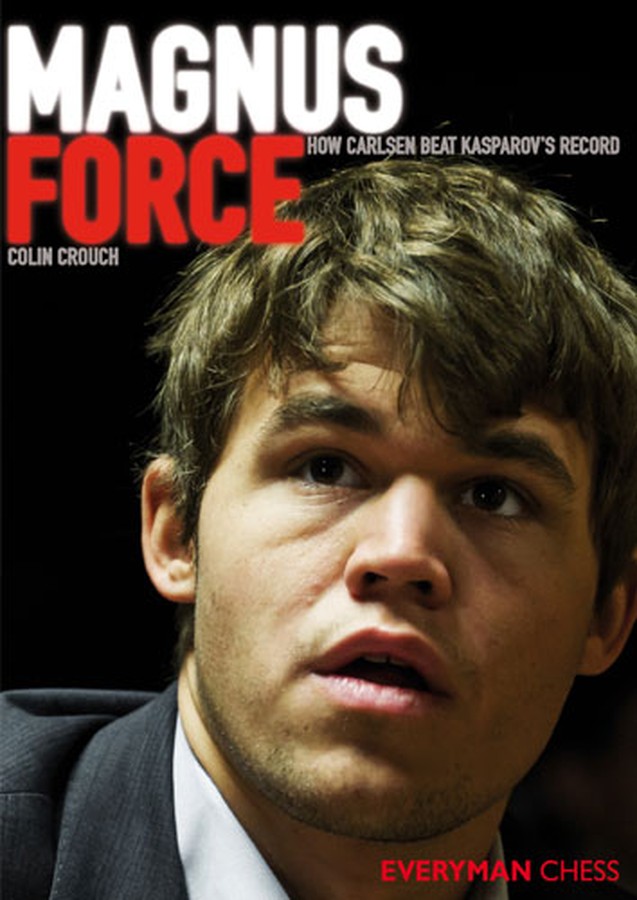| Nivå | B-D |
| Utgivelsesdato | Oktober 2013 |
| Forfatter | |
| Pris | 240 NOK |
Magnus Force
How Carlsen Beat Kasparov's RecordTil VM-matchen i 2013 ankom en duggfersk seriøs bok som analyserer Magnus Carlsens sjakkutvikling fra 2010 til da, og derunder hvordan han kunne slå Kasparovs ratingrekord. Glimrende partisamling!
Fra innledningen
The central idea of this book is to make a close examination of games by Magnus Carlsen, and two tournaments he won spectacularly, the London Classic 2012, and Wijk aan Zee 2013, in world-breaking style. Just look at his scores. We shall of course go through all of these games later.
Many readers may find it puzzling that the book starts off with a string of losses by Carlsen from the previous two years. The strong er and more experienced players will grasp the point immediately. To reach the top in chess, or even scale the minor peaks that most players have reached, it is not quite enough to win a few games. It is also necessary, even more so, to avoid defeats as far as possible. To improve your chess, and to go beyond your ‘natural’ plateau, what is important is to learn from your games, and learn deeply and in- tently. You want to do better next time, and to turn your previous weaknesses into strengths.
Carlsen cut down his losses quite dramatically during 2011 and early 2012, but even this is not quite enough. He avoided losses, but drew too many games, and quite often he needed great tenacity to avoid a few losses from slightly worse positions. He was faced with the old dilemma, that if a player wants to play a game extremely solidly, it is sometimes difficult to try to play for a win, but if he tries instead, from an early stage, to play for a win, he is placing himself in danger that he is out of his own comfort zone, as well as his opponents’.
This leads to what is most puzzling for che ss followers, that Carlsen seems to know almost no opening theory, and just seems to play chess on the hoof. It is not the sort of thing that Kasparov would approve of, when he had reached the top, but in his younger years he often speculated wildly in sharp tactical positions, and quite often won, not by playing the most accurate move, but rather trying to outplay his opponent in extremely sharp tactical lines, in which one slip by the opponent would easily end up in a loss. Kasparov later went for a fully scientific approach in the opening, trying to analyse everything in depth, at home, and testing his opponent how accurately he would play. It will take time before Carlsen will have his full depth of understanding and knowledge in the opening, and similarly too with Kasparov in his teens and early twenties. Carlsen, as his play matures, will become even more frightening to his opponent. At the moment though, there are still gaps in his knowledge and understanding.
Carlsen would appear to think about chess very much in the style of Emanuel Lasker, World Champion 1894-1921. All the time, he is thinking very much about his opponent, almost as much as the board. Naturally, like Lasker, he has an extremely deep understanding of the position, and given a straightforward technical edge, he will try to convert this without too much trouble. There is however a massive gap between what is happening in the start of the game, when all possibilities are open, and neither player has yet gone wrong; and a much later position , when one of the players is winning, or both players, after a battle, will end up with a draw, with best play by both sides.
The chess psychologist, gifted also with exceptionally clear thinking, will be trying to give himself every opportunity for his opponent to make a mistake, whether before move ten, or by move twenty, thirty, forty, or what ever. Carlsen also tries to grind out his opponent in the endgame, often a long way into the second session.
Carlsen, when playing against an opponent that he knows well, and an opponent he has analysed in depth, will tend to grasp very quickly his opponent’s strengths or weak- nesses. In preparing his openings, he will not try to catch up with the latest analysis twenty moves deep. He would be thinking instead of which sort of opening would make his opponent feel slightly uncomfortable, and therefore more likely to make a mistake.
Two examples come to mind, in the Ruy Lopez, as Black against Anand in the London Classic 2010, and as White agains t Aronian in 2012, at the same venue. In either case, Carlsen had outplayed his opponent in the opening, but somehow he lost his grip in the position, possibly relaxing too much, confident th at he had done the hard work of playing better than his renowned opponent. Against Anan d he overlooked a tactic and lost, while against Aronian, he won a pawn extremely quickly, but he allowed his pawns to become blocked, and it became far from clear that he was in fact winning. He did win, but one out of two was a meagre result from what should have been two wins against his strongest opponents. He made life much more difficult for himself.
Carlsen excels under pressure in positions when he is worse, and also in strategically complicated positions in which both players are forced to play with great care. He is not quite so convincing when it looks as if he is clearly better, and it seems a matter of technique to haul in the full point. Often he seem s to try to make life complicated, when all that is needed is simple chess. Of course, if the position is genuinely complicated, and requires difficult decisions on both sides, Carlsen is very much in his element.
Hvordan lykkes Crouch med det krevende bokprosjektet? Utdrag fra anmeldelsen på chessvibes.com:
The author’s goal is pretty clear from the Introduction:
The core of this book is to analyse all the games by Magnus Carlsen, in the London Classic, December 2012, and Wijk aan Zee, January 2013. This is just a small segment in time, but it is clearly the start of a new chapter of chess history.
It must be said that Crouch does a really good job achieving just that. His analyses are instructive, entertaining, honest, and most of all very, very thorough.
The first chapter alone is a masterstroke: Crouch starts off by taking a close look at a number of Carlsen’s recent losses. This approach is reminiscent of Edmar Mednis’ classic How to Beat Bobby Fischer and works very well to set the scene in Magnus Force, too: Crouch clearly doesn’t want to come across as yet another Carlsen fanboy and there’s really no better way to get that prejudice out of the way then by starting with the exceptionally poor form Carlsen displayed in 2010 and the start of 2011. About the 2010 London Chess Classic, for instance, Crouch says:
It has to be said that by general consensus, Carlsen was in a grumpy mood during the early part of the tournament, and was not all that talkative in the press conferences. Still, this is hardly surprising. A loss in a serious game of chess can badly affect the emotions, and all the more so if there is a second loss, not long after. It is difficult to hide such feelings on such occasions, all the more so, given that Carlsen had only just hit twenty. (…) His mood became darker when he lost to Vishy Anand in round 3 (after a win against Adams). No wonder.
| Innbundet? | Nei |
| Type | Bok |
| Språk | Engelsk |
| Antall sider | 286 |

